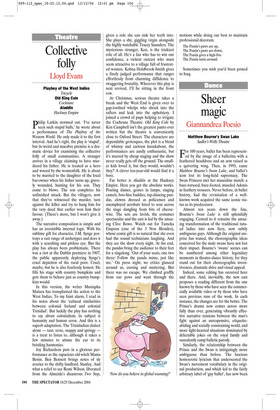Sheer magic
Giannandrea Poesio
Matthew Bourne’s Swan Lake Sadler’s Wells Theatre For 100 years, ballet has been represented by the image of a ballerina with a feathered headdress and an arm raised as a quivering wing. Then, in 1995, came Matthew Bourne’s Swan Lake, and ballet’s icon lost its long-held supremacy. The Swan Princess met her masculine match: a bare-torsoed, bare-footed, muscled Adonis in feathery trousers. Never before, in ballet history, had the revisitation of a wellknown work acquired the same iconic status as its predecessor.
Almost ten years down the line, Bourne’s Swan Lake is still splendidly engaging. Central to it remains the amazing transformation of the traditional tutued ladies into now fiery, now subtly ambiguous guys. Although the original surprise has waned, the choreographic ideas conceived for the male swans have not lost their impact. Bourne’s ‘swans’ scenes can be numbered among other legendary moments in theatre-dance history, for they stand out for their choreographic inventiveness, dramatic drive and visual appeal.
Indeed, some editing has occurred here and there. And, inevitably, the new cast proposes a reading different from the one known by those who have seen the commercially available video or by those who have seen previous runs of the work. In each instance, the changes are for the better. The Prince’s drama now comes across more fully than ever, generating vibrantly effective narrative tensions between the man’s fight against an unresponsive, etiquetteabiding and socially constraining world, and more light-hearted situations dominated by delectable jokes on the royal family and succulently camp balletic parody.
Similarly, the relationship between the Prince and the Swan is intriguingly more ambiguous than before. The luscious homoerotic lyricism that underscored the Swan’s movement vocabulary in the original production, and which led to the fairly arbitrary label of ‘gay ballet’, has now been replaced by a more fierce, almost feral approach to the choreography. It is never clear, therefore, what the Swan represents in the eyes of the Prince, for the Swan’s prowess challenges any immediate thought of love that does not dare to speak its name. And yet the boundaries between male bonding, male adoration and male desire remain splendidly thin, thanks to the ingenious choreographic layout. Such an intentional lack of clarity adds greatly to the dramatic depth of the narrative and provides the performers with a varied interpretative palette.
Neil Westmoreland, as the Prince, is certainly one of the artists who benefits most from such dramatic wealth. An excellent dancer, he is also a superb actor. His rendition of the unfortunate protagonist stands out for a gripping boyish characterisation, which adds considerably to his equally gripping depiction of the character’s gradual mental disintegration.
His Prince complements beautifully the now lustful, now unbearably strict Queen of Nicola Tranah, a real mother from hell, and matches perfectly his escapist idol/ object of desire, the Swan. The latter is José Tirado, who stands out for an imposing stage presence and extraordinarily powerful technical skills — notably the lightness and the ‘attack’ of his jumps. Yet, he can also display tenderness, though always in a dramatically tense but restrained way, thus adding an extra layer of mystery to his already mysterious role. Even his equivalent of the Black Swan mesmerises with an intoxicatingly individual extra dose of ambiguity.
Leigh Daniels, as the Prince’s girlfriend, also provides an interpretation that goes far beyond the caricature of the silly platinum-blonde starlet. Her darker side, highlighted by her murky deeds with the unsettling Private Secretary of Alan Mosley, keeps resonating throughout the party scene thanks to well-calibrated acting. I only wish she had considered the antics of the royal-box scene more, for they were a tad over the top the night I went.
The rest of the company is simply perfect. The excellent mix of dancing and silent acting works like clockwork, and there is never a moment in which the action deflates or drags. Even the party scene, despite being constructed on what in the ballet’s traditional version is a rather ornamental series of national dances, fits in perfectly with the dramatic development.
This Swan Lake might not be everyone’s ideal Christmas ballet. If it is just Christmas magic you are after, I strongly recommend you see the splendidly lavish Cinderella proposed by the Royal Ballet arguably the only version of the ballet worth seeing today — or any Nutcracker that traditionally pops up at this time of year together with pantos and Santa’s grottos. But, if it is sheer magic and theatre at its best that you are looking for, then Bourne’s Swan Lake is the one to see.


















































































 Previous page
Previous page